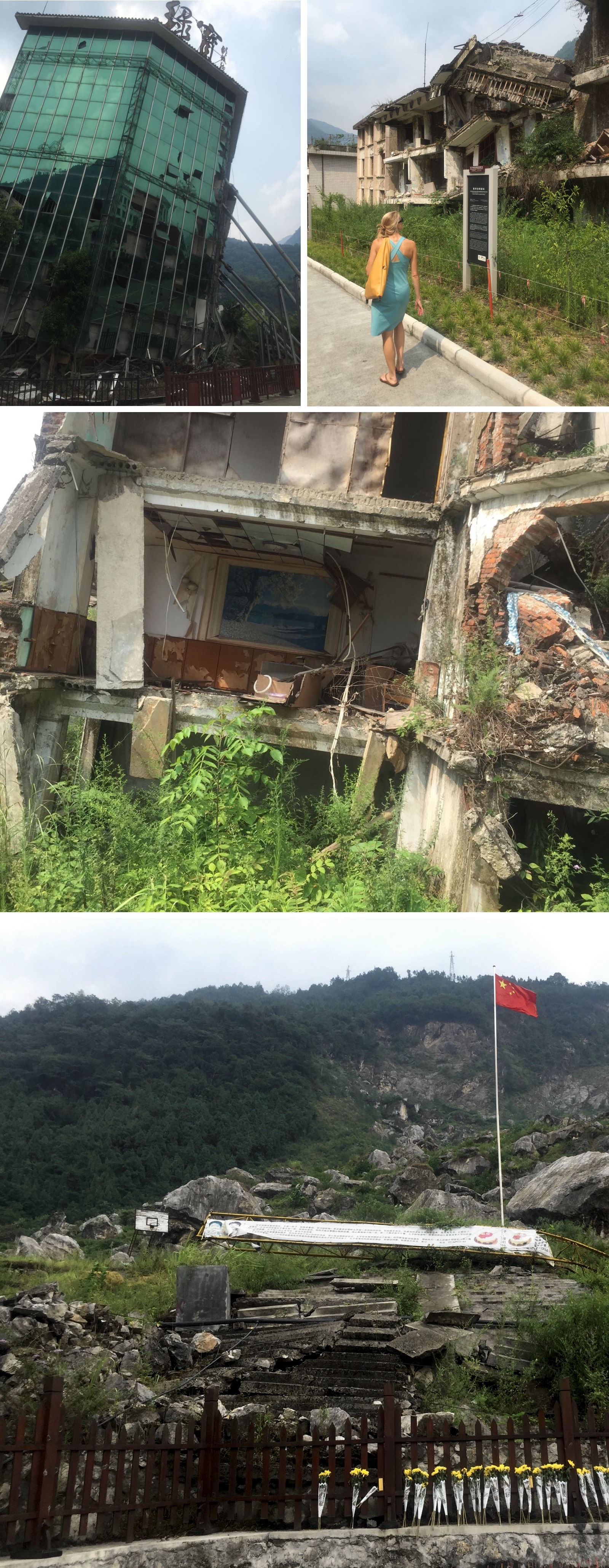Before heading out on our bike trip, we took a day to go to Beichuan, a strange and moving memorial to the huge 8.0-magnitude earthquake that devastated much of Sichuan province in 2008.
Earthquakes have been something of a recurring theme on our trip. The tragic Nepal earthquake struck just a week before we were scheduled to land in Kathmandu. We went to New Zealand instead, where we heard often about the lingering effects of the 2011 Christchurch quake, which so frightened residents that it has led to a mass exodus from the city. Our next stop, Indonesia, also has a long, sad history of earthquake damage, including the giant tsunami in Banda Aceh in 2004, which killed 167,000 people, and was caused by a 9.2-magnitude earthquake offshore in the Indian Ocean. Our friends in Manila have developed a detailed earthquake preparedness plan, knowing that the Philippine capital is due for a big one and that its infrastructure is woefully underprepared. And, of course, we’re about to move to San Francisco.
Beyond these anecdotes, if you compare our travel map to this map of global earthquake activity, you’ll see that we’ve been traveling through some of the world’s most geologically active regions. By visiting Beichuan, we wanted to do a small something to reckon with the huge human impact of these disasters.
The 2008 Sichuan quake is also an important and compelling story for another reason: it was a pressure point within China’s tense, ongoing internal struggle to define the boundaries of free speech within this unique economically liberalizing, but still politically repressive state. The quake’s massive death toll – something like 70,000, though the tallies are unreliable – and broader human impact – for example, somewhere between 4 and 12 million left homeless – was due in part to rampant neglect of construction standards. This led many buildings – including hundreds or possibly thousands schools – to collapse under strains they should have been able to withstand. In one the highest profile cases, 1,300 students and teachers in Beichuan’s middle school were buried when the school fell.
After the quake, the Chinese government undertook an aggressive campaign to suppress information about the disaster’s true impact, and especially to silence criticisms regarding the construction failures. The censorship and propaganda bureau issued an edict to the media banning coverage of the construction problems, and parents and others who demanded information were silenced, detained, and tried for “inciting subversion of the state.”
Still, the popular outcry proved impossible for the government to entirely suppress. The Beichuan memorial was part of the accommodation. Beichuan was a small town up the Sichuanese mountains, close to the quake’s epicenter. After the quake, Chinese officials determined that the damage to the city was so extensive that repair was impossible. Instead they decided to prop up the damaged buildings and construct a walking path through the ruins, turning them into a raw memorial to the dead.
The path through the ruins is peppered with signs showing photos of the city before the quake that provide a vivid contrast to the rubble that remains, stories of the bravery of residents in the face of the terrible destruction, and testaments to the heroic leadership of local Party officials in the chaotic aftermath. The net effect is a bit as if the U.S. government, after Hurricane Katrina, had turned the ruins of the Lower Ninth Ward into a permanent memorial to the destructive force of the hurricane, the resilience of New Orleans’ residence, and the competent, compassionate response of officials in DC.
The ruins themselves are powerful and disturbing. Many multistory buildings are now simply piles of rock. In others, the first story or two simply collapsed, leaving third story apartments and offices sitting at ground level atop the flattened remains of the old lower floors.
The most powerful site is the Beichuan middle school, buried by a landslide that followed the quake. All that remains is a basketball hoop, a flagpole, and flowers for the dead children.
Photos
